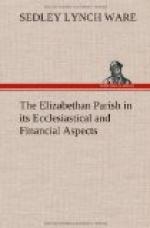Because of the alleged drunkenness and disorderly conduct attendant upon some of these ales, the justices of assize and the justices of the peace attempted in some shires to put them down on various occasions.[263] More effective, perhaps, in doing away with them was the gradual growth of Puritanism.
In conclusion it should be remarked that church-ales seem to have obtained only in Central and Southern England. The huge and thinly populated parishes of the North did not favor the development of an institution so essentially social in its character.
Church Plays, Games and Dances were allied in a measure with church-ales, partly because they were sometimes held concurrently with them, partly because they served as a substitute for the ales when these fell into disrepute. Miracle plays and other pageants were given by certain parishes from time to time, too frequently in the churches themselves, in which case the wrath of the ordinary was called down upon the parish if he heard of them.[264] Some parishes kept various costumes and stage properties, which were hired out to other parishes when not in use.[265] May games, Robin Hood plays or bowers, Hocktide sports and forfeits, morris-dances and children’s dances were all turned to the profit of the church, collections being taken up at them.[266] Morris coats, caps, bells and feathers were frequently loaned out for a consideration by wardens to other parishes.[267]
Church-house. Here were the brewing kettles and the spits, and here was stored church grain or malt for beer making.[268] Here, too, presumably, the pewter ale pots, trenchers, spoons, etc., which figure in the accounts, were kept. These were hired out to other parishes for their ales.[269] While ale was brewed and drunk in the church-house for the benefit of the parish, and that apparently on other occasions than church-ales, it does not seem probable that the place was often allowed to degenerate into a common ale-house, even though in some parishes it may have borne the name of “church tavern."[270] When not required for parish purposes the church-house was rented out, and rooms in an upper story were used for lodging.[271]
As church-ales fell into disfavor Offerings or Gatherings in church or at the church door became more frequent[272] and more systematized. As time went on these collections were regularly taken up in many parishes every quarter, usually at Easter, Midsummer, Michaelmas and Christmas.[273] Hence the name quarterage.[274] When the proceeds went to general church furnishing and repairing, the gatherings wrere sometimes called in the accounts “church works."[275] As the sum given by each was often noted down in “quarter books” or “Easter books,"[276] and was, on denial, occasionally sued for before the official (together with dues for other purposes—clerk’s wages, pew rents, etc., presently to be noticed), an “offering” might become virtually an assessment or rate.[277]




